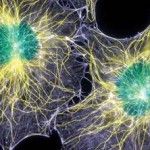Life: Defining Life

The basic constituents of life are also the most common elements in the universe: carbon, oxygen, hydrogen, nitrogen. Many biochemists therefore regard the emergence of life as inevitable wherever the right chemical and environmental conditions exist. That view is reinforced by the knowledge that conditions on Earth that sustain life are extremely diverse. But what, exactly, is life? Life is chemistry, and it started somehow by shifting from inanimate to animate molecules. Enough ambiguity in this respect exists that defining life is still difficult.
The major defining characteristics of life are metabolism, self-replication, and adaptability. A genuine life form has to possess all three characteristics. Some structures seem life-like but do not contain all the necessary features. For example, there are inanimate auto-catalytic molecules that self-replicate, but they do not have metabolic mechanisms. And then there are the viruses, highly adaptable entities that contain RNA (or sometimes DNA) but can replicate themselves only by pirating the cellular machinery of live organisms. And the issue is further complicated by ambiguous states of animacy. There are organisms that can exist in a state of suspended animation for extremely long periods of time. The levels of animacy and the mechanisms that control are of great interest and underscore the need to understand the nature of life better.
Properties of Life.
Nucleotides. Earth life is based on combinations of only 20 amino acids which form the proteins necessary for life. From these proteins, molecules called monomers first developed, and eventually monomers combined to form more complex molecules called polymers. Polymers in turn formed nucleotides —the basis of genes. Just how these extraordinary molecules formed is still unclear.
The cell. The molecules of a living organism require a liquid environment surrounded by a dual membrane. The internal membrane keeps the fluid in, while the external membrane shields the contents from the outside. The dual membrane is designed to take in nutrients from the outside and expel waste. The first primitive cell was adequate for the rudimentary processes of proto-life forms, but very limited compared to the sophisticated structure of the modern cell.
Homeostasis and metabolism. The living cell must capture and convert sources of energy to maintain its survival. Nutrients vary from one organism to another: ultra-violet light, minerals, gases, other forms of life. And the cell's metabolism depends absolutely on enzymes —specific proteins— to accelerate the chemical processing of nutrients as well as other basic functions. To ensure the efficiency of these mechanisms the cell requires a system that responds to energy changes. This is represented by the citric acid, or Kreb's, cycle.
Self-Replication. All living things contain a genetic blueprint that is copied within the cell to reproduce the next generation. At the most rudimentary level, the archaea and prokaryote types of cells, the cell simply divides, generating clones that in turn mature and repeat the reproductive cycle. The evolution of eukaryotic cells introduced the cell nucleus and its more complex mechanisms. All complex organisms derived from eukaryotic cells.
Adaptation. Living organisms must be able to adjust to environmental change in the form of temperature, food and other conditions. All life forms have therefore some level of adaptability, but some organisms have more flexibility in this respect than others. For example, the first living organisms were anaerobic (and many types of bacteria and archea are still anaerobic). As plant life evolved more oxygen was added to the Earth's atmosphere, and this was toxic for most life forms at the time. Many organisms that had thrived in a predominantly CO2 environment perished. Radical changes in climate and atmosphere have caused periodic extinctions in the history of the Earth and opportunities for other forms of life.
